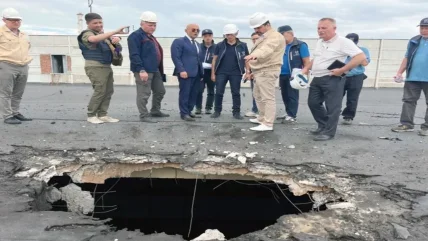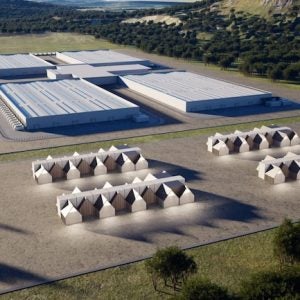
On 19 October [2022] Russia’s Defence Ministry said the Russian army had destroyed a Ukrainian landing force at Zaporizhia NPP (ZNPP), adding that Kiev had lost more than 90 military personnel and 14 boats. “Today [10 April], at about 4 am, Ukrainian forces of up to two companies made another attempt to land troops on the left bank of the Kakhovsky reservoir and seize the territory of the nuclear power plant,” the MOD report said. The ministry noted that the Russian forces guarding the outer perimeter of the plant had destroyed the attacking troops. Vladimir Rogov, a member of the main (pro Russian) Council of the Zaporozhye region administration said the battle lasted more than three hours. In addition, Ukrainian Armed Forces had fired US-supplied Himars multiple launch rockets at the operators’ city of Energodar leaving it without electricity.
This attack was denied by Ukraine at the time and its version of events was widely reported in the Western media. Now, however, The London-based Times has confirmed that the attack took place and has provided details. “Ukraine’s secret attempt to retake the Zaporizhzhia nuclear plant” cites representatives of the Ukrainian Special Forces, military intelligence and the navy personnel.
“In the dead of night last October a Ukrainian special forces team boarded a 40ft armoured patrol boat, taking up positions at its three heavy machineguns and Mk19 automatic grenade launcher,” The Times said. “They were among nearly 600 elite troops scattered along the north bank of the Dnipro River, which carves through Zaporizhzhia region. The teams boarded more than 30 vessels bristling with weapons, formidable gifts from friends in the West.
Their orders: to launch an assault to recapture the Zaporizhzhia nuclear power plant from the Russians on the opposite bank.”
Since Russia took control of ZNPP in March 2022, the Russian national guard has been protecting the station and in October, Russian President Vladimir Putin signed a decree formally transferring ZNPP to Russian jurisdiction under nuclear utility Rosenergoatom (part of Rosatom). A Russian Federal State Unitary Enterprise. Zaporizhia NPP was established by Rosenergoatom to operate the plant.
According to the Times, “the Ukrainian soldiers were excited” about the attack. “If they survived the war, their mission would be one to tell their grandchildren about, an officer involved said.” The idea was that this would be an infantry-only battle. “They wouldn’t be able to use artillery against us, as this is a nuclear plant,” the officer reportedly said. The soldiers were drawn from Ukraine’s military intelligence (GUR) and included the Shaman battalion, the Kraken Regiment and the Ukrainian Foreign Legion. They were “already battle-hardened” but “none of them expected the resistance they would face at the power plant”.
The Times quoted the officer as saying: “The Russians built a very dense defence, they mined everything. When we were approaching they even pulled up tanks and artillery and started firing at us right on the water.” Ukrainian President Zelensky’s administration had appealed to the United Nations to help evict Russia’s forces, the paper said, but weeks of diplomacy had failed and “Ukraine decided to take matters into its own hands.”
Special forces speedboats attempted to cross a stretch of river nearly three miles wide supported by precision Himars rockets provided by the US. The Times said: “Asked whether the US had provided targets for the Himars before the raid, a US defence source confirmed that “time-sensitive” intelligence was provided to Ukrainian special forces, although they declined to give specific details.”
However, heavy shelling from Russian troops forced most of the boats to retreat. A handful of the Ukrainian special forces teams in smaller boats managed to make it to the shore … engaging the Russians in a three-hour firefight on the outskirts of the town of Enerhodar. According to “a special forces officer”, a lot of lives were saved because the commander of the operation decided to retreat.
The Times quoted Petro Kotin, head of Ukraine’s nuclear utility Energoatom as saying the operation was dangerous “If our army can advance south towards Crimea, toward Melitopol, this is the only option [to retake the plant] – no direct shelling of the plant, no direct advance on the territory of the plant with direct actions against the Russians. It is very dangerous to do such things near nuclear material. Any damage will bring radiation to the people and to the whole world.”
Kotin added, however that “the greatest threat to the plant remains the Russian presence”. He reportedly said the Russians were “using control centres as barracks, installing gun emplacements on the roofs of plant buildings and constructing fortifications close to storage sites of radioactive material. They keep ammunition trucks inside the reactors’ turbine halls, risking a nuclear incident that could blight Ukraine for decades.” However, this seems unlikely as the International Atomic Energy Agency (IAEA) inspection mission, which is permanently present at the plant, has reported no such violations. Moreover, according to Rosatom, the “fortification” was built to protect the used fuel storage facility from repeated Ukrainian shelling and drone attacks.
According to Russia’s MOD This was the fourth time Ukrainian forces had tried to storm the ZNPP using large numbers of troops and boats – the other occasions being on 1, 2-3 and 8-9 September. The first such attack, on 1 September had delayed the arrival of the first IAEA team to ZNPP. Russia’s MOD said this had involved two Ukrainian sabotage groups totalling 60 people using seven high-speed motor boats. They had been detected and apprehended by the Rosgvardiya units guarding the territory of the ZNPP. Another landing attempt to capture the plant was foiled an hour later when an attempt was made to land tactical troops on two self-propelled barges.
After the MOD said it was “bewildered” at the lack of UN reaction to the Ukrainian attempt to seize ZNPP by force, Stephane Dujarric spokesman for the Secretary-General told reporters: “We are glad that the Russian Federation did what it needed to do to keep our inspectors safe.”
The MOD said the second attempt on 2 September involved “two groups of boats and motorboats totalling 42 units with a landing force of over 250 people from the special operations forces and foreign mercenaries who attempted to land on the coast of the Kakhovsky reservoir in the area of Energodar and Dneproprudny. The Ministry added that Russian aircraft and helicopters had destroyed 20 of the boats. The rest had turned around and left.
The Times report came shortly after IAEA Director General Rafael Grossi had paid a second visit to ZNPP following talks with Zelensky in Dniepro. He then held talks with Russian officials in Kaliningrad. The Times had erroneously reported that the IAEA had been trying to negotiate a demilitarised zone around ZNPP. More accurately Gross had been trying to get agreement on a security and protection zone around the plant rather than demilitarisation of the area. However, after failing to make progress on this, despite Russia’s support for such a plan, he is now seeking simply agreement from both sides to refrain from any military activity targeting the NPP.
Following Grossi’s visit to the plant, Russia’s Permanent Representative to the international organisations in Vienna, Mikhail Ulyanov, said that chances of reaching an agreement on ensuring the safety of ZNPP are small. Russian Foreign Ministry spokeswoman Maria Zakharova said Russia is continuing to work on the parameters of creating a special security zone around the plant but that this dialogue is not developing easily as the Ukraine authorities “are not ready to commit themselves not to attack the station and support the IAEA”. Although The Times quoted Kotin at length, the Energoatom website does not mention the article, neither does the Ukrainian National News Agency, Ukrinform.






